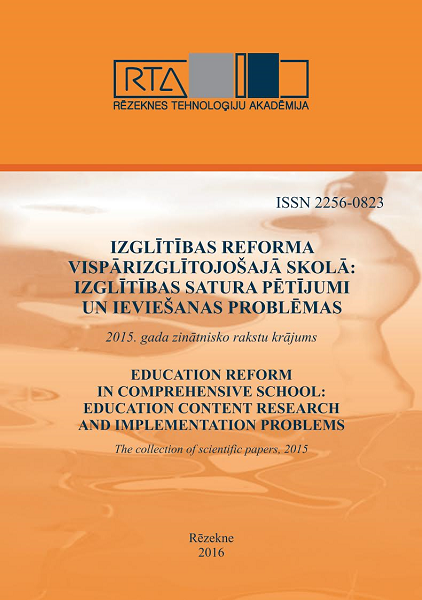THE KNOT SCRIPT – THE LOST WRITING SYSTEM OF THE LATVIAN LANGUAGE
DOI:
https://doi.org/10.17770/ercs2016.2178Keywords:
clew, folk songs, knot alphabet, knot records, knot script, knot writing, Latvia, Latvian language, Lithuania, quipu, song ball, song clew, Vismantai, writing system, yarn ballAbstract
The article analyses a writing system of the Latvian language that has been scarcely researched before. The evidence of the usage of the knot script and song clews is present in the Latvian folklore, although it has been commonly considered as a metaphor. At the beginning of the 20th century there were individuals still using it prior to the conventional literacy increase due to the general education. Similar knot scripts can be found in several cultures around the globe. The article encompasses a study of previous researches and evidence in periodicals, Latvian community in Lithuania, education of commoners in Latvia, reciprocal comparison of the Latvian knot script writing systems, interview with a contemporary witness and experiment on reconstruction of the Latvian knot script.
References
Benninghoven, F. (1965). Der Orden der Schwertbrüder: fratres milicie Christi de Livonia. Köln: Böhlau, 1965. p. 525.
Briņķis, J. (1940). Zemgaļu cilts Lietuvā. Magazina Nr.416. Rīga: Dailes Magazina. p. 27.
Ceipe, G. (2011). Brāļu draudzes vēsture. Rīga: Brāļu draudzes misija. http://www.bdm.lv/index.php/bralu-draudzes-vesture
Dārziņš, V. (1965). Tautas dziesmu balsis. Chicago: Labietis. p. 287-290.
Dogiel, M. (1758). Codex Diplomaticvs Regni Poloniæ et Magni Dvcatvs Litvaniæ. Vilnæ: Ex Typographia Regia, p. 33-35.
Eniņš, G. (1993). Kur pazuduši mezglu rakstu kamoli? Diena Nr.25. Rīga: Diena. p. 3.
Grāvītis, V., Lukašinska I. (1980). Dziesmu kamols – mezglu raksti. In: Labietis Nr.59 01.01.1980. p.1734.
Inga. (2014). Lietuvos istorinė ir kultūrinė situacija 1918 – 1940 metais. Vilnius: Lietuvių kalba ir literatūra. http://lietuviukalbairliteratura.lt/lietuvos-istorine-ir-kulturine-situacija-1918-1940-metais-i-dalis/
Jēkabsons, Ē. (2006). Latvijas un Lietuvas robežas izveidošanās. Rīga: Republika.lv. http://www.tvnet.lv/zinas/latvija/207802-latvijas_un_lietuvas_robezas_izveidosanas
Jundzis, E. (1985). Senlatviešu cilpu un mezglu raksti. Rīga: (n.p.). p. 153.
Jundzis, E. (1996). Mezglu raksti – īstenība un minējumi. Pavalstnieks Nr.269. Rīga: Pilsonis. p.7.
Každailis, D. (2012). Lietuvos gyventojai 2011 metais. Vilnius: Lietuvos statistikos departamentas. p 43.
Kļaviņa, S. (1997). Valodas daba. Lielvārde: Lielvārds. p.79.
LD. Dainu skapis. Rīga: Latviešu folkloras krātuve.http://dainuskapis.lv/izversta-meklesana/?ld=27796
Legge, J. (1891). The Sacred Books of the East Vol. XXXIX. The Sacred Books of China. The Texts of Taoism. Oxford: Clarendon Press. p. 396.
LFK. (2005). Krišjāņa Barona Dainu skapis. Rīga: Latviešu folkloras krātuve. http://www.lfk.lv/dainu_skapis.html
LFMI. (2016). Latviešu folkloras krātuves izbraukuma seminars Limbažos. Rīga: LU LFMI. http://www.lfmi.lu.lv/?id=993&r=foto/video:-latviesu-folkloras-kratuves-izbraukuma-seminars-limbazos
LNVM. (2016). Ancient History of Latvia (11 000 BC - 1200). Riga: National History Museum of Latvia. http://lnvm.lv/en/?page_id=863
Łowmiański, H. (1931). Studja nad początkami społeczeństwa i państwa Litewskiego. Wilno: Towarzystwo Przyjaciół Nauk. p. 95.
Meyer, L. (1876). Livländische Reimchronik. Paderborn: Ferdinand Schöningh. p. 261-266.
Миловский, А. (1987). Узелок для памяти. Вокруг света 6 1987. Moscow: Молодая гвардия. p. 38-41.
Mugurēvičs, Ē. (1997). Ethnic processes in Baltic inhabited territories, and the emergence of the Latvian nation in the 6th to the 16th century. Humanities and Social Sciences Latvia, University of Latvia, vol.3 (16), p. 75-92.
Nukata, I. (1993). Nihonshidaijiten 2. Ketsujou. Tokyo: Heibonsha. p. 1326.
Periodika. (2016). Periodika. Riga: LNB. http://periodika.lndb.lv/#searchResults;simpleQuery=mezgl%20rakst
O’Connor, K. (2015). The History of the Baltic States 2nd Edition. Santa Barbara: Greenwood. p. 298.
Ozoliņš, A. (2015). Tāss ciba, photograph, viewed January 9, 2016, http://www.la.lv/tasu-rakstu-magija/3/
Salnītis, V. (1938). Latvijas kultūras statistika. 1918.-1937.gads. Rīga: Valsts statistiskā pārvalde. p. 99.
Skudra, Ž. (2014). Nedaudz no Bilēķu vēstures. Saldus: Vadakstes pagasta bibliotēka. http://vadakstesmantojums.saldus.lv/index.php/gramata/764-nedaudz-no-bileku-vestures
Skujenieks, M. (1930). Trešā tautas skaitīšana Latvijā 1930.gadā. Rīga: Valsts statistiskā pārvalde. p. 337.
Straubergs, K. (1949). Lettisk folktro om de döda. Stockholm: Nordiska museet. p. 140.
The Great Soviet Encyclopedia. (1979). New York: Macmillan. http://encyclopedia2.thefreedictionary.com/Total+literacy+rate
UIS. Latvia – Literacy rate. (2011). Montreal: UNESCO Institute for Statistics. http://www.indexmundi.com/facts/latvia/literacy-rate.






